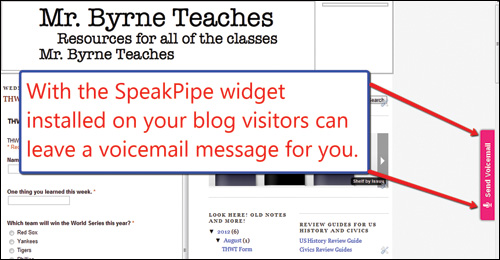It’s a new school year and that means you’ll be getting to know a whole new group of students and parents. Building relationships and communicating with them is an important part of your job, but where to begin? This month, I’m recommending few tools that will help you build those relationships. So don’t wait to get started toward forging those connections.
 The first relationship-building tool that I always recommend to educators is a classroom or library blog. In terms of platforms, I’m partial to Blogger because it integrates with my Google account, but there are many other good ones that you might want to try, including Posterous Spaces, an easy-to-start, user-friendly interface for teachers, and EduBlogs.
The first relationship-building tool that I always recommend to educators is a classroom or library blog. In terms of platforms, I’m partial to Blogger because it integrates with my Google account, but there are many other good ones that you might want to try, including Posterous Spaces, an easy-to-start, user-friendly interface for teachers, and EduBlogs.
What’s my number-one tip for any educator who wants students and parents to visit his classroom blog regularly? Blog consistently, even if you don’t think anyone, especially at the beginning of the school year, is reading your posts. It may take a while to get them into the habit of checking your blog for important information, but if you blog each day and consistently refer students and parents to your site from the get-go, I’ll bet that by November, they’ll be regular visitors, looking forward to reading your latest posts.
These days, almost every parent and student has a mobile device. If you’re not taking advantage of mobile technology to engage your classroom community, you need to start right now. There are many excellent, free tools that you can use to connect with students and parents through their mobile devices, and the following are a few of my favorites.
Kikutext uses text messages to keep parents informed about your classroom or libray. The service is an opt-in one for parents. So when you create a Kikutext account, you’re assigned a code to distribute to parents. Parents then send that code in a text message to register, or opt in, to receive your messages. Kikutext keeps parents’, teachers’, and principals’ phone numbers hidden from each other, so they’re confidential.
Remind 101 allows you to send text messages from your computer to groups of students and parents. Like most of the other services I’m recommending, Remind 101 uses an opt-in system. So students and parents who want to receive messages must enter a code to elect to receive them.
For the last two years I’ve given out my Google Voice number to students and their parents, and included it on my printed syllabuses. I’ve also distributed the number by installing a Google Voice-calling widget on my blog. Then anyone viewing my blog can call or text me directly from my site. When you create a Google Voice account, you have the option to select a new number—that’s what I did when I created mine. I hand out that number so that students and parents can text message me or leave me a voice mail. I can reply to text messages from my Google Voice inbox and the other party never sees my real cell phone number.
 If Google Voice isn’t for you, there’s always SpeakPipe, which offers a good voice-calling widget that’s easy to add to your blog. With SpeakPipe installed on your blog, anyone can click on the “send voicemail” button and leave you a message. When a visitor clicks the “leave voicemail” button she’ll be prompted to allow access to her computer. Then she can begin recording her message. Visitors can, but aren’t required to, enter their names and email addresses for you. And you can listen to and download any messages from your SpeakPipe inbox.
If Google Voice isn’t for you, there’s always SpeakPipe, which offers a good voice-calling widget that’s easy to add to your blog. With SpeakPipe installed on your blog, anyone can click on the “send voicemail” button and leave you a message. When a visitor clicks the “leave voicemail” button she’ll be prompted to allow access to her computer. Then she can begin recording her message. Visitors can, but aren’t required to, enter their names and email addresses for you. And you can listen to and download any messages from your SpeakPipe inbox.
So don’t wait until the first open house or parent-teacher night to start reaching out to parents. Begin building relationships from the first day of school by taking advantage of the many ways you can communicate with parents through blogs and via mobile.



Just a note on one of the sites mentioned in this article: Posterous Spaces, will be shutting down as of April 30, so I see no point in starting a blog there!